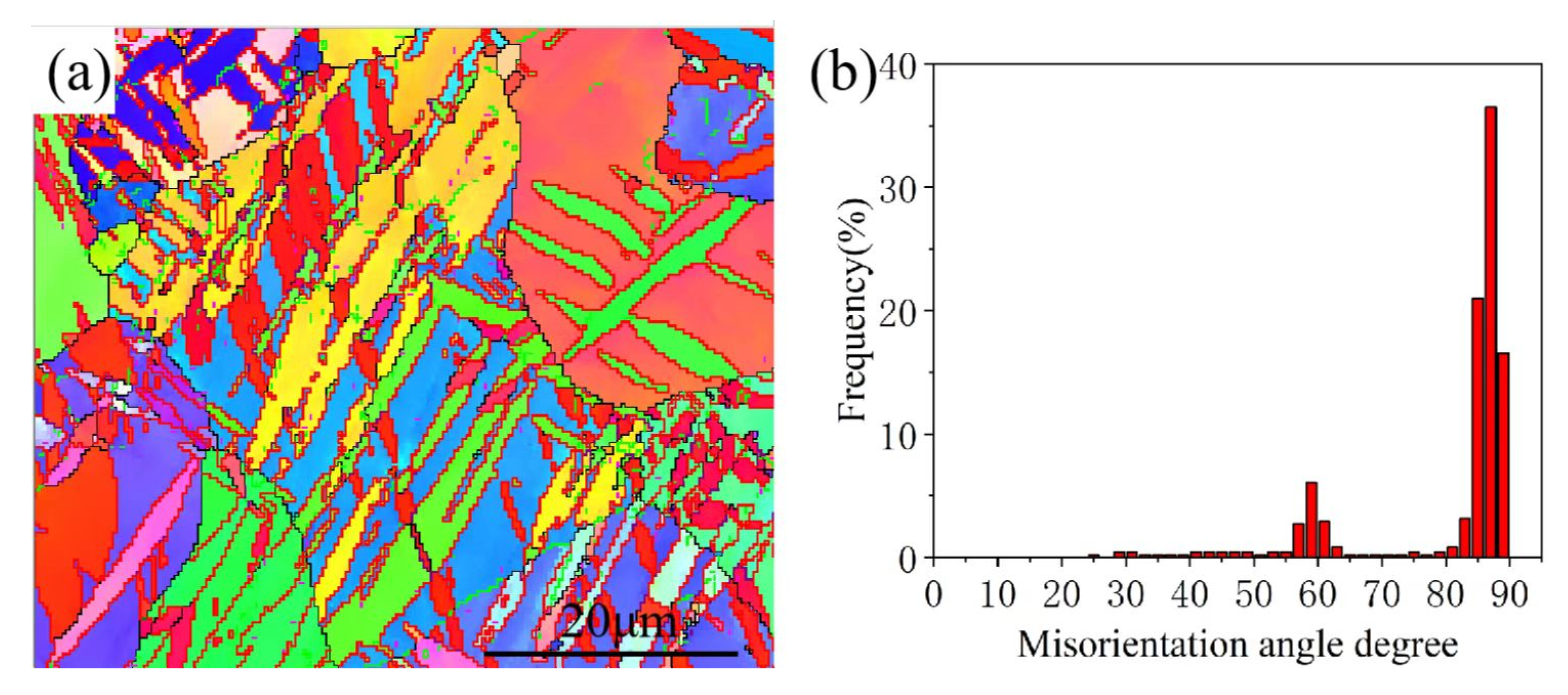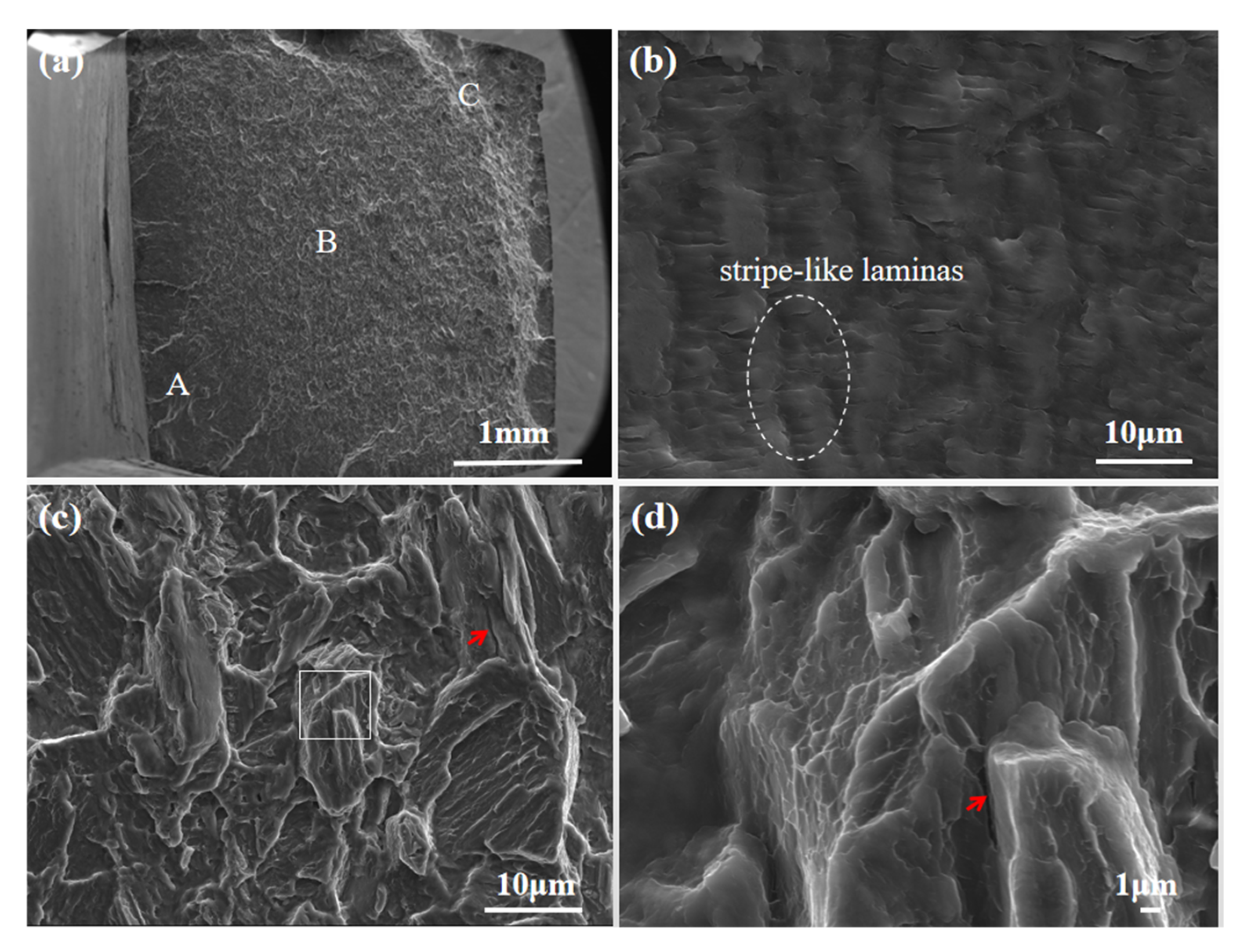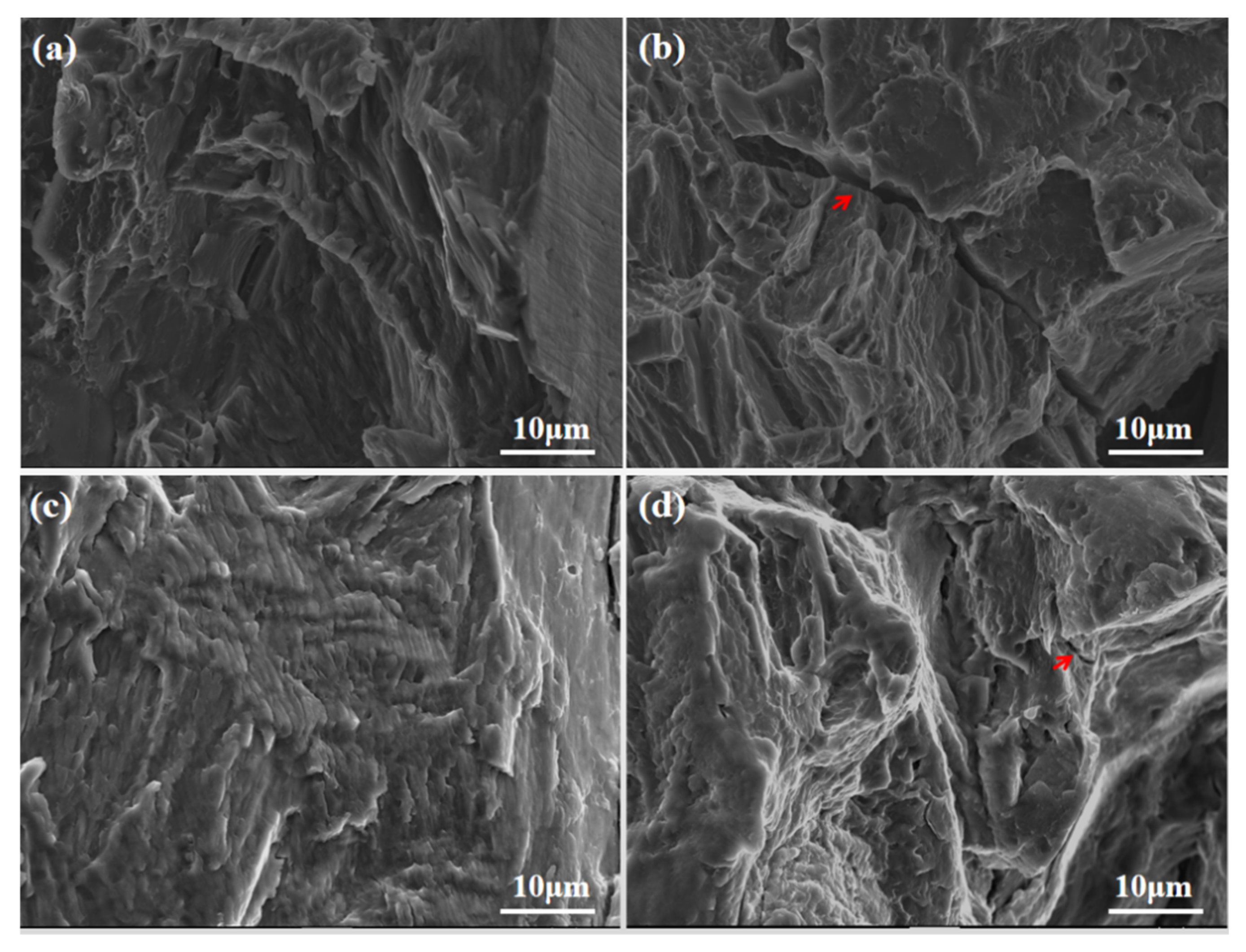Activation Behavior of {10-12}-{10-12} Secondary Twins by Different Strain Variables and Different Loading Directions during Fatigue Deformation of AZ31 Magnesium Alloy
Abstract
:1. Introduction
2. Experimental Procedure
3. Results and Discussion
3.1. Fatigue Behavior
3.2. Surface Microstructure Characteristics of the Sample
3.3. Microstructure Characteristics of the Fracture Surface
4. Conclusions
Author Contributions
Funding
Acknowledgments
Conflicts of Interest
References
- Nie, J.F.; Shin, K.S.; Zeng, Z.R. Microstructure, deformation, and property of wrought magnesium alloys. Metall. Mater. Trans. A 2020, 51, 6045–6109. [Google Scholar] [CrossRef]
- Shu, Y.; Zhang, X.Y.; Yu, J.P.; Li, T.A.N.; Yin, R.S.; Qing, L.I.U. Tensile behaviors of fatigued AZ31 magnesium alloy. Trans. Nonferrous Met. Soc. 2018, 28, 896–901. [Google Scholar] [CrossRef]
- Lee, S.W.; Kim, S.H.; Jo, W.K.; Hong, W.H.; Kim, W.; Moon, B.G.; Park, S.H. Twinning and slip behaviors and microstructural evolutions of extruded Mg-1Gd alloy with rare-earth texture during tensile deformation. J. Alloy. Compd. 2019, 791, 700–710. [Google Scholar] [CrossRef]
- Culbertson, D.; Jiang, Y. An experimental study of the orientation effect on fatigue crack propagation in rolled AZ31B magnesium alloy. Mat. Sci. Eng. A 2016, 676, 10–19. [Google Scholar] [CrossRef]
- Guo, P.; Liu, X.; Zhu, B.; Liu, W.; Zhang, L. The microstructure evolution and deformation mechanism in a casting AM80 magnesium alloy under ultra-high strain rate loading. J. Magnes. Alloy 2021, in press. [Google Scholar] [CrossRef]
- Cheng, Y.; Fu, Y.; Xin, Y.; Chen, G.; Wu, P.; Huang, X.; Liu, Q. {102} twinning behavior under biaxial tension of Mg–3Al–1Zn plate. Int. J. Plast. 2020, 132, 102754. [Google Scholar] [CrossRef]
- Wang, H.M.; Li, S.M.; Li, D.Y.; Proust, G.; Gan, Y.; Yan, K.; Tang, D.; Wu, P.; Peng, Y. Modeling twinning, detwinning, and dynamic recrystallization of magnesium alloys. MRS Bull. 2019, 44, 873–877. [Google Scholar] [CrossRef]
- Mokdad, F.; Chen, D.L.; Li, D.Y. Twin-twin interactions and contraction twin formation in an extruded magnesium alloy subjected to an alteration of compressive direction. J. Alloy. Compd. 2018, 737, 549–560. [Google Scholar] [CrossRef]
- Barnett, M.R. Twinning and the ductility of magnesium alloys: Part I:“Tension” twins. Mat. Sci. Eng. A 2007, 464, 1–7. [Google Scholar] [CrossRef]
- Barnett, M.R. Twinning and the ductility of magnesium alloys Part II. “Contraction” twins. Mat. Sci. Eng. A 2007, 464, 8–16. [Google Scholar] [CrossRef]
- Tan, L.; Zhang, X.; Xia, T.; Sun, Q.; Huang, G.; Xin, R.; Liu, Q. {10–12}−{10–12} double tensile twinning in a Mg-3Al-1Zn alloy sheet during cyclic deformation. Mat. Sci. Eng. A 2018, 711, 205–211. [Google Scholar] [CrossRef]
- Yu, Q.; Jiang, Y.; Wang, J. Cyclic deformation and fatigue damage in single-crystal magnesium under fully reversed strain-controlled tension–compression in the [1 0 1¯ 0] direction. Scr. Mater. 2015, 96, 41–44. [Google Scholar]
- Lentz, M.; Behringer, A.; Fahrenson, C.; Beyerlein, I.J.; Reimers, W. Grain Size Effects on Primary, Secondary, and Tertiary Twin Development in Mg-4 wt pct Li (-1 wt pct Al) Alloys. Metall. Mater. Trans. A 2014, 45, 4737–4741. [Google Scholar] [CrossRef]
- Xin, Y.C.; Zhou, X.J.; Lv, L.C.; Liu, Q. The influence of a secondary twin on the detwinning deformation of a primary twin in Mg–3Al–1Zn alloy. Mat. Sci. Eng. A 2014, 606, 81–91. [Google Scholar] [CrossRef]
- Li, Q.; Yu, Q.; Zhang, J.; Jiang, Y. Effect of strain amplitude on tension-compression fatigue behavior of extruded Mg6Al1ZnA magnesium alloy. Scr. Mater. 2010, 62, 778–781. [Google Scholar] [CrossRef]
- Matsuzuki, M.; Horibe, S. Analysis of fatigue damage process in magnesium alloy AZ31. Mat. Sci. Eng. A 2009, 504, 169–174. [Google Scholar] [CrossRef]
- Yang, P.F.; Yang, Z.Y.; Li, L.; Sun, Q.; Tan, L.; Ma, X.; Zhu, M. Towards understanding double extension twinning behaviors in magnesium alloy during uniaxial tension deformation. J. Alloy. Compd. 2022, 894, 162491. [Google Scholar] [CrossRef]
- Yin, S.M.; Yang, H.J.; Li, S.X.; Wu, S.D.; Yang, F. Cyclic deformation behavior of as-extruded Mg-3%Al-1% Zn. Scr. Mater. 2008, 58, 751–754. [Google Scholar] [CrossRef]
- Xiong, Y.; Yu, Q.; Jiang, Y. Multiaxial fatigue of extruded AZ31B magnesium alloy. Mat. Sci. Eng. A 2012, 546, 119–128. [Google Scholar] [CrossRef]
- Wu, B.L.; Duan, G.S.; Du, X.H.; Song, L.H.; Zhang, Y.D.; Philippe, M.J.; Esling, C. In situ investigation of extension twinning-detwinning and its effect on the mechanical behavior of AZ31B magnesium alloy. Mater. Des. 2017, 132, 57–65. [Google Scholar] [CrossRef]
- Hong, S.G.; Park, S.H.; Lee, C.S. Enhancing the fatigue property of rolled AZ31 magnesium alloy by controlling {10-12} twinning-detwinning characteristics. J. Mater. Res. 2010, 25, 784–792. [Google Scholar] [CrossRef]
- Xiong, Y.; Yu, Q.; Jiang, Y. An experimental study of cyclic plastic deformation of extruded ZK60 magnesium alloy under uniaxial loading at room temperature. Int. J. Plast. 2014, 53, 107–124. [Google Scholar] [CrossRef]
- Dong, S.; Yu, Q.; Jiang, Y.; Dong, J.; Wang, F.; Jin, L.; Ding, W. Characteristic cyclic plastic deformation in ZK60 magnesium alloy. Int. J. Plast. 2017, 91, 25–47. [Google Scholar] [CrossRef]
- Park, S.H.; Hong, S.G.; Bang, W.; Lee, C.S. Effect of anisotropy on the low-cycle fatigue behavior of rolled AZ31 magnesium alloy. Mat. Sci. Eng. A 2010, 527, 417–423. [Google Scholar] [CrossRef]
- Xiong, Y.; Jiang, Y. Cyclic deformation and fatigue of rolled AZ80 magnesium alloy along different material orientations. Mat. Sci. Eng. A 2016, 677, 58–67. [Google Scholar] [CrossRef]
- Wu, L.; Agnew, S.R.; Ren, Y.; Brown, D.W.; Clausen, B.; Stoica, G.M.; Liaw, P.K. The effects of texture and extension twinning on the low-cycle fatigue behavior of a rolled magnesium alloy, AZ31B. Mat. Sci. Eng. A 2010, 527, 7057–7067. [Google Scholar] [CrossRef]
- Mu, S.; Jonas, J.J.; Gottstein, G. Variant selection of primary, secondary and tertiary twins in a deformed Mg alloy. Acta Mater. 2012, 60, 2043–2053. [Google Scholar] [CrossRef]
- Song, L.H.; Wu, B.L.; Zhang, L.; Du, X.; Wang, Y.; Esling, C.; Philippe, M.J. Detwinning-related Bauschinger effect of an extruded magnesium alloy AZ31B. Mater. Charact. 2019, 148, 63–70. [Google Scholar] [CrossRef]
- Sun, Q.; Xia, T.; Tan, L.; Tu, J.; Zhang, M.; Zhu, M.; Zhang, X. Influence of {10–12} twin characteristics on detwinning in Mg-3Al-1Zn alloy. Mat. Sci. Eng. A 2018, 735, 243–249. [Google Scholar] [CrossRef]
- Xin, R.L.; Ding, C.H.; Guo, C.F.; Liu, Q. Crystallographic analysis on the activation of multiple twins in rolled AZ31 Mg alloy sheets during uniaxial and plane strain compression. Mat. Sci. Eng. A 2016, 652, 42–50. [Google Scholar] [CrossRef]
- Lentz, M.; Risse, M.; Schaefer, N.; Reimers, W.; Beyerlein, I.J. Strength and ductility with {10–11}-{10–12} double twinning in a magnesium alloy. Nat. Commun. 2016, 7, 11068. [Google Scholar] [CrossRef]
- Jain, J.; Zou, J.; Sinclair, C.W.; Poole, W.J. Double tensile twinning in a Mg-8Al-0.5 Zn alloy. J. Microsc. 2011, 242, 26–36. [Google Scholar] [CrossRef] [PubMed]
- Hazeli, K.; Askari, H.; Cuadra, J.; Streller, F.; Carpick, R.W.; Zbib, H.M.; Kontsos, A. Microstructure-sensitive investigation of magnesium alloy fatigue. Int. J. Plast. 2015, 68, 55–76. [Google Scholar] [CrossRef]







| Twin Type | Twins | Misorientation Axis | Misorientation Angle |
|---|---|---|---|
| Tensile twin | {10-12} | <1-210> | 86.3° |
| Compression twins | {10-11} | <1-210> | 56° |
| {10-13} | <1-210> | 64° | |
| Secondary twin | {10-11}-{10-12} | <1-210> | 38° |
| {10-13}-{10-12} | <1-210> | 22° | |
| {10-12}-{-1012} | <1-210> | 7.4° | |
| {10-12}-{01-12} | <1-210> | 60° | |
| {10-12}-{0-112} | <8-1-70> | 60.4° |
| Samples | {10-12} Twin | {10-12}-{10-12} Double Twin |
|---|---|---|
| strain amplitude of 1% along ND | 41.2% | 21.1% |
| strain amplitude of 1% along RD | 43.8% | - |
| strain amplitude of 0.5% along ND | 5.45% | - |
| strain amplitude of 0.5% along RD | 7.4% | - |
Publisher’s Note: MDPI stays neutral with regard to jurisdictional claims in published maps and institutional affiliations. |
© 2022 by the authors. Licensee MDPI, Basel, Switzerland. This article is an open access article distributed under the terms and conditions of the Creative Commons Attribution (CC BY) license (https://creativecommons.org/licenses/by/4.0/).
Share and Cite
Tan, L.; Huang, X.; Wang, Y.; Sun, Q.; Zhang, Y.; Tu, J.; Zhou, Z. Activation Behavior of {10-12}-{10-12} Secondary Twins by Different Strain Variables and Different Loading Directions during Fatigue Deformation of AZ31 Magnesium Alloy. Metals 2022, 12, 1433. https://doi.org/10.3390/met12091433
Tan L, Huang X, Wang Y, Sun Q, Zhang Y, Tu J, Zhou Z. Activation Behavior of {10-12}-{10-12} Secondary Twins by Different Strain Variables and Different Loading Directions during Fatigue Deformation of AZ31 Magnesium Alloy. Metals. 2022; 12(9):1433. https://doi.org/10.3390/met12091433
Chicago/Turabian StyleTan, Li, Xingyu Huang, Yizhi Wang, Qi Sun, Yanbin Zhang, Jian Tu, and Zhiming Zhou. 2022. "Activation Behavior of {10-12}-{10-12} Secondary Twins by Different Strain Variables and Different Loading Directions during Fatigue Deformation of AZ31 Magnesium Alloy" Metals 12, no. 9: 1433. https://doi.org/10.3390/met12091433
APA StyleTan, L., Huang, X., Wang, Y., Sun, Q., Zhang, Y., Tu, J., & Zhou, Z. (2022). Activation Behavior of {10-12}-{10-12} Secondary Twins by Different Strain Variables and Different Loading Directions during Fatigue Deformation of AZ31 Magnesium Alloy. Metals, 12(9), 1433. https://doi.org/10.3390/met12091433






